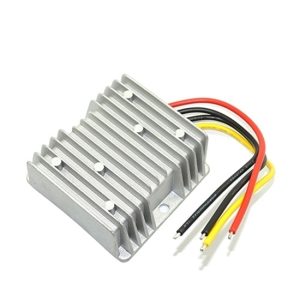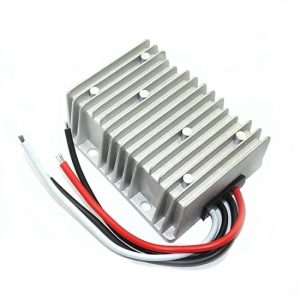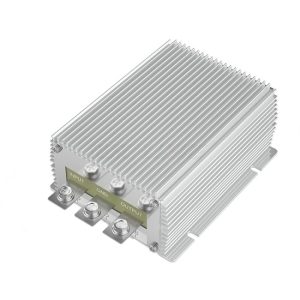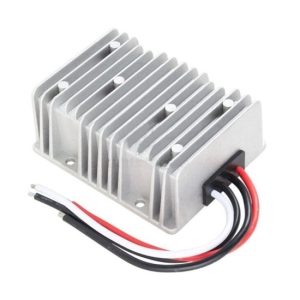The DC to DC converters or DC choppers is those power electronics circuits that convert a DC voltage source to another DC voltage source of different value and sometimes different polarity. The DC-DC converters find application in the following areas:
- Electric power supplies for telecommunication systems
- Electric power transmission systems
- Photovoltaic power generation systems
- Switched-mode power supplies for electric and electronic circuits
- Power factor correction for diode rectifier topologies
- DC motor drive systems
Classification of DC-DC converters
There are multiple types of DC-DC converters. The simplest form of the DC-DC converter is the linear converter, also called linear voltage regulator.
A linear voltage regulator can only work as a buck DC-DC converter, which means that will only lower a higher voltage level. Being a regulator, it also ensures that the output voltage is maintained at a specific value, even if the output load is variable.
A more efficient type of DC-DC converter is the switching DC-DC converter. There are several topologies of switching DC-DC converters, the most common being presented in the image below.
The most common classification is from the ratio between the input and output voltage point of view: Boost DC-DC converters, Buck DC-DC converters.
In a boost DC-DC converter, the output voltage is higher than the input voltage. Due to power conservation (if we ignore the losses), the output current will be lower than the input current.
Principle of operation of a DC-DC boost converter
In a buck DC-DC converter, the output voltage is lower than the input voltage. Due to power conservation (if we ignore the losses), the output current will be higher than the input current.
Types and Characteristics of DC/DC Converters: DC/DC converters are available in two circuit types:
- Non- Isolated types:
- Basic (one coil) type
- Capacity coupling (two-coil) type – SEPIC, Zeta, etc.
- Charge pump (switched capacitor/coil-less) type
- Isolated types:
- Transformer coupling types – Forward transformer type
- Transformer coupling types – Fly-back transformer type
With the basic type circuit, the operation is limited to either stepping up or stepping down to minimize the number of parts, and the input side and the output sides are not insulated.
With SEPIC and Zeta, a capacitor is inserted between VIN and VOUT of the step-up circuit and the step-down circuit of the basic type, and a single-coil is added. They can be configured as step-up or step-down DC-DC converters by using a step-up DC-DC controller IC and a step-down DC-DC controller IC, respectively. The charge pump type requires no coil, enabling to minimize the mounting area and height.
DC-DC power converters provide the means to change one DC voltage to another. It is more usual for the conversion to be to a lower voltage, although step-up converters are available and have significant potential for the future. DC-DC power converters are fed from a DC supply usually comprising an uncontrolled AC to DC converter or alternatively a battery supply; the controlled DC output can then be used to control a DC machine as in the case of the controlled AC to DC converters. DC drives employing controlled AC to DC converters have several important limitations which are overcome by the DC-DC converter: DC-DC converters find application mainly in DC servodrives, rail traction drives and small fractional kW drives employing permanent magnet motors.
Since step-down converters are of greatest practical importance emphasis shall be placed on their consideration. For the purpose of illustration bipolar transistors will be considered however MOSFET, IGBT and GTO’s are widely used.
What is the purpose of the converter in a DC drive? – The basic purpose of the DC-DC conversion is to change the DC voltage level (Lower: buck, higher: boost). It could also be used for insulation purposes. Generally, the DC-DC converter is the core of any converter.
How does a DC Converter Work? The basic DC-DC converter will take the current and pass it through a “switching element”. This turns the signal into a square wave, which is actually AC. The wave then passes through another filter, which turns it back into a DC signal of the appropriate voltage necessary.
Selecting the right DC-DC converter for maximum battery life:
Choosing the right converter topology for a power supply usually starts by considering input and output voltages. If the input voltage is always higher than the required output voltage, a buck converter is the first choice, and if the input voltage is always lower than the required output voltage, a boost converter is the best bet. With battery-powered devices, this is not always so easy. A typical lithium-ion (Li-ion) battery voltage, for example, can change from 4.35 V down to 2.5 V during the discharge cycle. If we need to generate a fixed voltage within this range, the first solution that comes to mind is a non-inverting buck-boost converter. But is this always the best choice? Like in many engineering problems, the answer is – it depends. One has to consider which design goals are most important. When it comes to battery life, which is often one of the most important design goals, depending on the design parameters, all three basic converter topologies i.e. boost, buck, and buck-boost topology may have advantages over the others.
Choosing the best converter topology for a battery application should take into account the battery discharge profile and the type and profile of the load, besides the voltage levels. Depending on specific conditions, all three basic topologies may be the best choice to achieve the longest battery life. The best way to select the right device is to compare them directly through measurements.
ATO provides DC-DC buck converters and DC-DC boost converters series with a wide power range and cheap prices. Buck converters are designed to step down 24V/36V/48V to 12V, 48V to 24V. The boost converters are the opposite, to step up 12V to 24V/36V/48V, 24V to 48V. They are used in portable electronic devices such as cellular phones and laptop computers, which are supplied with power from batteries. A few models a worth mentioning here:
DC-DC Buck Converter, 12V/24V to 5V: This series of DC-DC power converters are DC-DC buck converters with a wide input range of 8V to 36V, high conversion efficiency up to 95%, is designed to step down the input rated voltage 12V/24V DC to 5V output voltage. Different models are available. https://www.ato.com/dc-dc-buck-converter-12v-24v-to-5v.
DC-DC Buck Converter, 48V to 24V: 48V DC to 24V DC buck converter series with different models from 3 amps to 63 amps, 72 watts to 1500 watts, 35V-60V input voltage range, high efficiency up to 98%, IP68 for the body. https://www.ato.com/dc-dc-buck-converter-48v-to-24v
DC-DC Boost Converter, 12V to 48V: DC-DC boost converter series, output current from 1 amp to 20 amps to select, 10-25V wide input voltage range, is designed to step up 12V DC to 48V DC, high transfer efficiency and stable performance. https://www.ato.com/dc-dc-boost-converter-12v-to-48v
DC-DC Boost-Buck Converter, 9V-36V to 24V: DC-DC boost-buck converter is lightweight and compact, with a wide input voltage range of 8V to 36V, high conversion efficiency up to 97%, step up or step down the input rated voltage 12V/24V to output voltage 24V. https://www.ato.com/dc-dc-boost-converter-12v-to-24v















